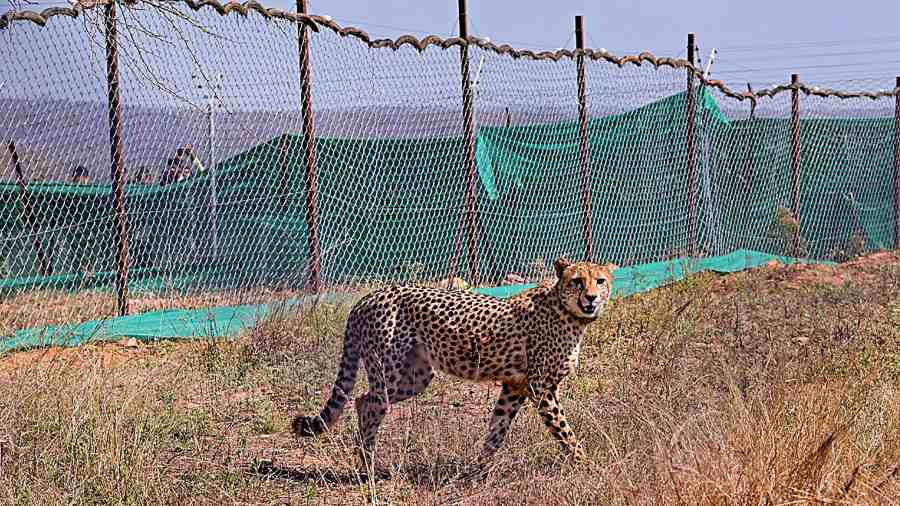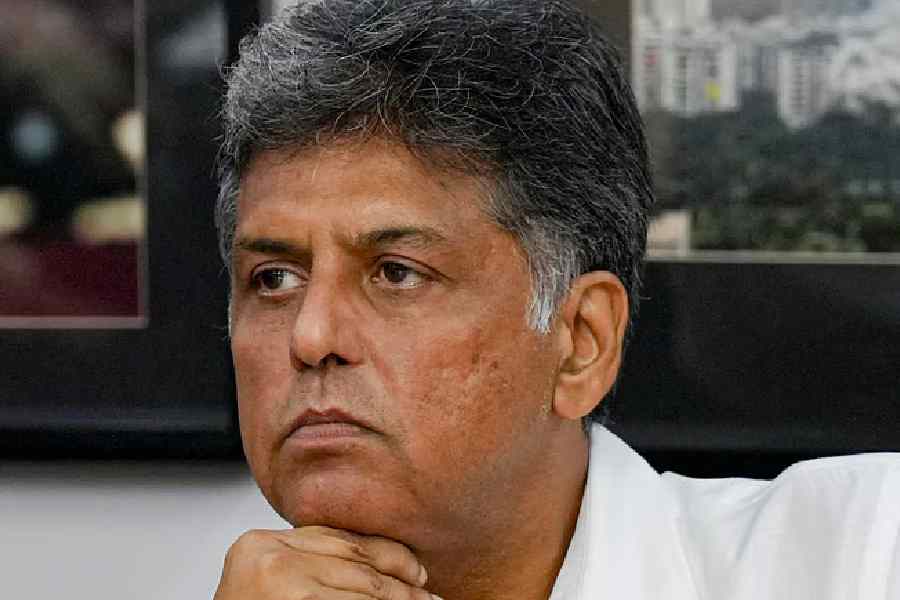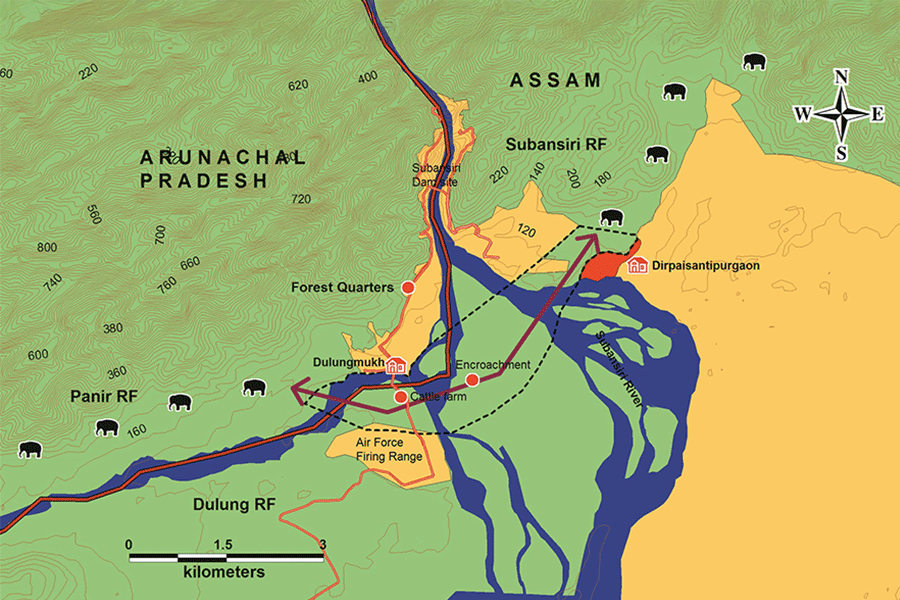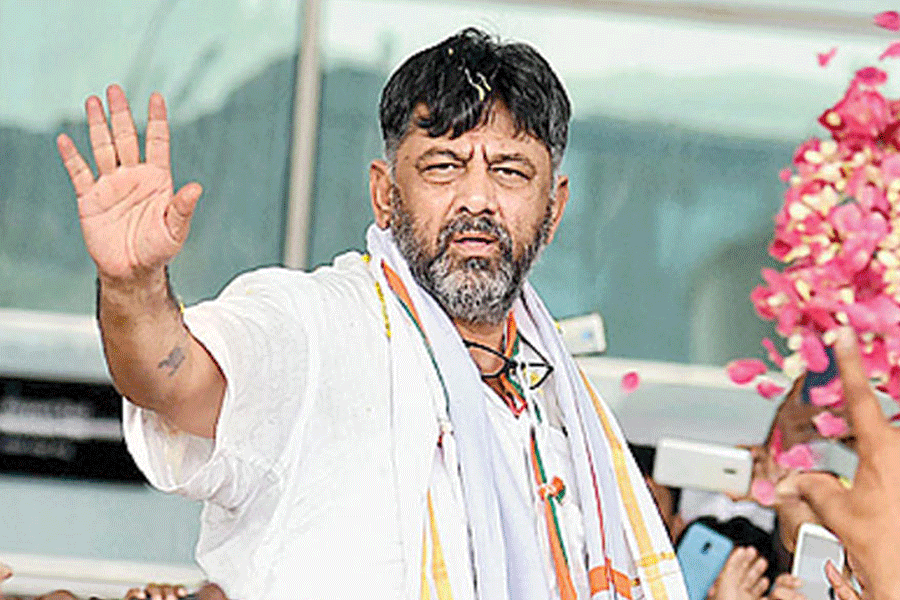Uday’s post-mortem report is awaited but a video that was filmed when the cheetah was in fine fettle in South Africa less than a year ago tells a heart-breaking tale.
The frames show a magnificent work of nature at full pelt, the fastest animal on land unleashing raw power to glide over the African terrain with grace and elegance, beating two-legged creatures and a machine in pursuit with a tranquiliser gun.
It is a breathtaking sight — a race to preserve the freedom all living beings yearn for.
At some point, speed did give way to guile, and the cheetah was translocated to India where it was named Uday.
On Sunday, the cheetah collapsed and breathed its last behind a fence in Kuno National Park, Madhya Pradesh. Uday was 6.
Wildlife experts are waiting for the post-mortem results to reveal what caused the sudden death of the cheetah but suspect that months of captivity had been detrimental to its health.
Uday was free-roaming wild and healthy in South Africa’s Waterberg region last year before it was captured 10 months ago. It died within hours of becoming ill within a fenced enclosure on Sunday.
It was one of 12 wild cheetahs from South Africa brought to Kuno in February this year to support India’s cheetah introduction project, which seeks to establish wild cheetah populations in protected areas.

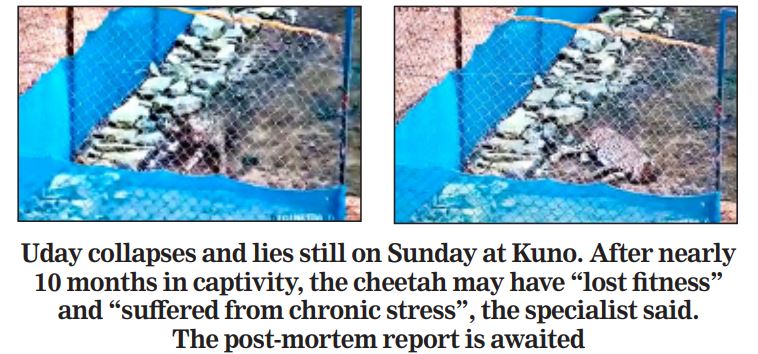
The cheetah’s papers, generated in February, had described it as being in “excellent health” and “extremely skittish”, unapproachable by humans or vehicles to within 70 metres.
India had flown in eight cheetahs from Namibia in September last year, received in Kuno in the presence of Prime Minister Narendra Modi. But except for four Namibian cheetahs released into the open wild last month, the others have remained within fenced enclosures.
Uday had appeared healthy a day earlier but showed telltale signs of being unwell on Sunday morning.
“The vet team had no real chance to save him -- it is very difficult to manage a wild animal in a critical condition like that, especially when the symptoms could be caused by very different things that take time for lab tests to confirm,” said Adrian Tordiffe, a cheetah specialist at the University of Pretoria, South Africa, now in Kuno.
The possible causes include severe botulism, poisoning by a toxin formed by clostridium bacteria in something the cheetah ate or drank, or a snake bite, he said.
Whatever may have caused the death, the continued captivity of most of the cheetahs within fenced enclosures remains a concern because multiple studies have shown that wild cheetahs can develop chronic stress when placed in captivity.
“Stress over long periods can reduce the immune response towards disease-causing organisms,” said Bettina Wachter, an evolutionary ecologist at the Leibniz Institute of Zoo and Wildlife Research in Berlin, Germany, and expert on cheetah behaviour.
The cheetah introduction plan document, prepared by the Wildlife Institute of India, Dehradun, the National Tiger Conservation Authority and the Madhya Pradesh forest department, had said that Kuno’s 748sqkm sprawl could sustain up to 21 cheetahs.
Wachter and others have questioned that estimate, saying that cheetah behaviour in two different African ecosystems suggests that territorial males require areas separated by 20-23km, implying that Kuno’s 17km-by-44km dimensions could at the most hold three territorial males.
Among the four cheetahs released in the open wild, one named Oban/ Pavan has ventured outside Kuno’s boundaries and approached villages several times over the past month.
He has been put back within a fenced enclosure to “hopefully calm his wandering spirit”, an expert tracking the project said.
Some experts are also concerned that in addition to the chronic stress from long periods in captivity, the cheetahs are being deprived of their ideal diet in the fenced enclosures.
“The natural diet for cheetahs includes chital, sambar, nilgai, springbuck or the impala -- but in the enclosures they are fed water buffalo and goat meat,” said a cheetah conservation expert from one of the five African countries -- Botswana, Kenya, Namibia, South Africa, and Tanzania -- that have cheetahs in the wild.
One of the eight Namibian cheetahs died on March 27 after battling kidney disease, which some scientists say is a known complication among cheetahs that have spent long periods in captivity.
Extra sites plea
The Madhya Pradesh forest department has written to the Centre requesting the preparation of additional sites for cheetahs as proposed in the cheetah introduction plan. But a senior forest official asserted that the request had nothing to do with any space constraints in Kuno or Sunday’s cheetah death.
“We received 20 cheetahs and have lost two cheetahs, but we now have 22 cheetahs,” said Jasbir Singh Chauhan, principal chief conservator of forests in Madhya Pradesh, referring to the birth of four cubs to a Namibian cheetah named Siyaya last month.
“We believe that Kuno can hold 21 cheetahs as mentioned in the plan, but it will be in the best interest of the project and the species to have more than one (site) for long-term survival of the cheetah in India -- more so because we can expect more cheetah cubs in Kuno,” Chauhan told The Telegraph.
Siyaya and her four cubs are currently in a fenced enclosure in Kuno.
A Press Trust of India report quoted an unnamed Madhya Pradesh forest official as saying that the department had asked the Centre for additional sites, citing “lack of logistical support and space”.
“We need nine staffers to keep an eye on one cheetah round the clock. We don’t have enough hands,” the official told PTI, requesting anonymity.
Asked about space shortage, the official said the concerns over space were secondary and added that it was “not just space, we need a lot of logistics”.

